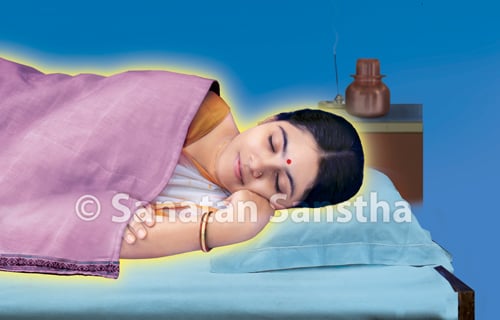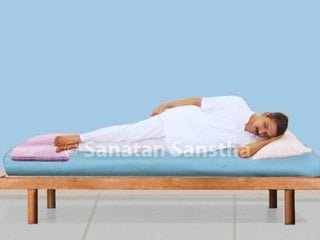
1. Thumb rules
The purpose of sleeping is to give rest to our physical body. From this viewpoint ‘the body posture which gives the body maximum rest is the best. This is a thumb rule. The most comfortable posture varies based on the state of an individual at a given point of time. The posture that you can take is in your hands only until you fall asleep, thereafter it is beyond your control.
2. Analysis of the different sleeping postures
There can be four sleeping postures –
2A. Sleeping in the prone (on the abdomen) posture
If newborn babies and little children are made to sleep in this way then they can get suffocated. Hence they should not be put to sleep in this posture. By doing so in comparison with other postures there is more strain on the backbone.
2B. Sleeping in the supine (on the back) posture
When we stand if we consider the strain on the backbone to be 100% then in the lying down posture this becomes 25 %. As in the supine posture the strain on the backbone is minimum for individuals with disorders of the back this proves beneficial. If a small pillow is kept under the knees when sleeping in this posture then the backbone remains even more relaxed.
2B 1. Association between sleeping in the supine posture and snoring
Snoring of those who snore increases in the supine posture. Snoring occurs when the inner mucosa of the throat obstructs breathing. This obstruction increases in the supine posture. Since sleeping in the lateral position removes this obstruction, snoring stops. This is what several experience with respect to snoring.
2C. Sleeping in lateral posture
In this posture in comparison with standing the strain on the backbone is 75%. Sleeping in the right lateral posture facilitates activation of the Chandranadi (Moon channel) and sleeping in the left lateral posture, that of the Suryanadi (Sun channel).
प्राक्शिरा दक्षिणाननो दक्षिणशिराः प्रागाननो वा स्वपेत् । – Acharendu, Shayanvidhiprayog
Meaning : Sleep with the head in the east or south
Since the Scriptures advise sleeping in the lateral position there is no need to change the sleeping posture to fulfil different needs, rather it would be better to sleep in the lateral position.
2C 1. Process occurring by sleeping in the lateral posture
When you sleep in the lateral position the nostril which is at a lower level gradually gets blocked. When this reaches a particular point you change your posture. So that nostril opens gradually and the nostril which is now lower begins to get blocked. As nostrils get blocked alternately, in sleep itself after sometime you change your position.
2D. Benefits from changing postures in sleep
Daily one fourth of the day is spent in sleep. Sleeping in the same posture throughout can cause bedsores due to the pressure.
– Vaidya Meghraj Madhav Paradkar, Sanatan ashram, Ramnathi, Goa (15.12.2018)

 When and how much should one sleep ?
When and how much should one sleep ? What is the ideal position for sleeping ?
What is the ideal position for sleeping ? How to fall asleep fast?
How to fall asleep fast? Simple Ayurvedic remedies for sound sleep
Simple Ayurvedic remedies for sound sleep If you are unable to fall asleep then try removing the black energy enveloping (avran)...
If you are unable to fall asleep then try removing the black energy enveloping (avran)... Importance of sound sleep
Importance of sound sleep